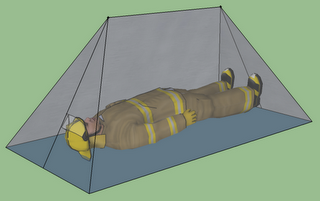Available in other languages: /fi /fr /pt /sr
A Hexayurt H2 is a hexayurt-style structure with space for a single person or cozy couple and a few personal effects, nothing more. It is roughly the size of a single person hiking tent or a capsule hotel. The footprint is 4' x 8' with a height of 41 inches (a 6' person can sit straight inside).
Materials[edit | edit source]
- 2 structural panels (polyiso, plywood or cardboard as appropriate for a hexayurt)
- plastic or canvas tarp larger than 8' x 4'
- 1 roll bi-directional filament tape
- 1 roll duct tape
- Optional: 1 roll foil tape
The tarp is for the floor. In a hot environment (ie: Burning Man), the floor should be non-insulating so the ground acts as a temperature regulator. In colder environments, an insulated floor is preferred, but polyiso panels may not be able to hold bodyweight without crushing.
Construction[edit | edit source]
- On each panel, cut a line from one corner to a point 2' in on the long side. You will be left with two walls that are isosceles trapezoids with an 8' base and a 4' top, and four right-angle triangles with a base of 2' and a height of 4'.
- Bevel the 8' side of each wall panel at a 26.5° angle, so the walls will lie flat on the ground when they form the edges of a triangle.
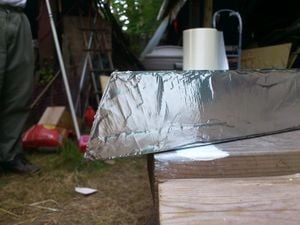
- On each wall panel, make a flange/lip out of duct tape folded back on itself along the angled edge. This will hold the door in place and prevent dust from blowing in around gaps. (On the prototype featured in the photo, this was done after erection.)
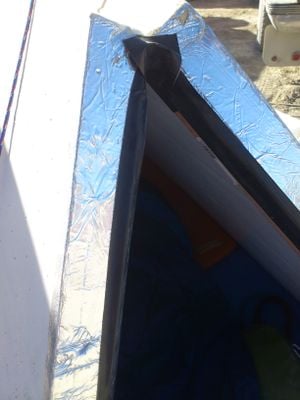
- Tape each pair of triangles along the 4' edge, edges together.
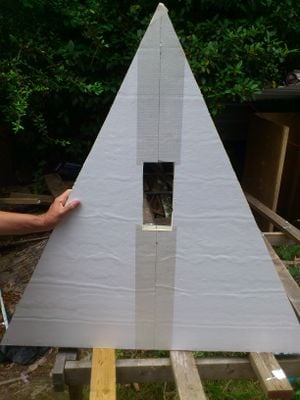
- Tape the two 4' tops of the walls lying parallel like a book binding to make a hinge (Camp Danger Hexayurt Hinge Technique). Each wall should have one flange facing the flange on the other.
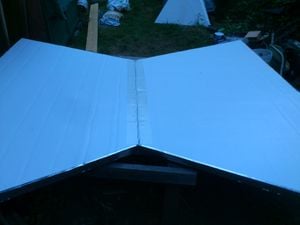
- Seal all exposed edges with foil or bidirectional filament tape.
- Tape the tarp to the exterior bottoms of the walls so that the tarp is taut when the walls are spread to form a triangular prism with a 4 foot base (ie: once the tarp is taped, the wall bottoms cannot be spread further than 4 feet). This should be done with the end pieces positioned for fit - for a smoothly opening door the base should be slightly wider than 4 feet.
At this point the H2 is ready for transport. The walls fold together with the tarp tucked inside or poking out. The two triangular end pieces can lay parallel to the walls so the whole thing can be sandwiched inside plywood panels for protection.
Note that the flange is necessary because the panels are three-dimensional. The ends cannot be caps, but fit *into* the ends.
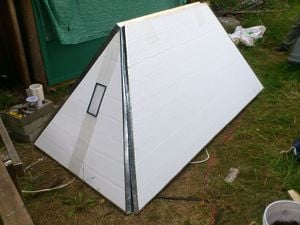
Enhancements[edit | edit source]
- Cut a hole in one end panel for attaching a swamp cooler duct
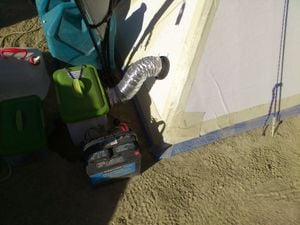
- Build a furnace filter into the other end panel to increase airflow
Erection[edit | edit source]
The H2 can be erected easily by one person.
- For maximum cooling, erect the H2 so that the door faces directly away from the sun at its zenith.
- Open the walls with the tarp taut on the ground. The tarp prevents downward force (including gravity) from collapsing the structure outward.
- Tape one of the triangular end pieces to the diagonal wall ends and tarp. The end piece prevents inward force from collapsing the structure upward.
- Tape the other triangular end piece only to the tarp. This is the door.
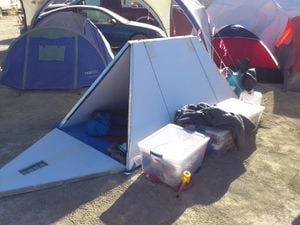
- Run lines (rope or nylon webbing) over the top of the structure and stake them down. Although the structure is aerodynamic, wind could gust under the wall and fill the tarp. These ropes also help prevent inward force from collapsing the structure upward.
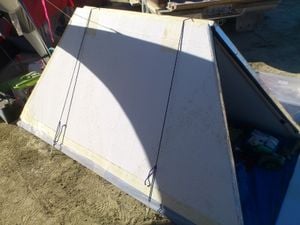
Use[edit | edit source]
A prototype used at Burning Man 2012 was built by Russ Warren and Jared Warren, and sponsored by Harrison Bros.[1]. It used 2" polyiso panels painted white.
I discovered that one person's body heat was sufficient to heat a closed H2 to an uncomfortable level. The swamp cooler I had was insufficient for cooling the H2 in the middle of the afternoon and the furnace filter [2] duct didn't seem to increase airflow very much. My typical use was to prop the door vertical while sleeping at night to provide airflow and open the door all the way once the sun rose in the morning. I was able to sleep comfortably until approximately 10:30AM. I wasn't inside the H2 during any dust storms, but wind never blew the door in and very little dust ended up inside.
The foil tape was not very durable and I would tape the edges with filament or duct tape on the next build. I shipped the H2 on a trailer wrapped in a tarp but with no plywood panels protecting it - it got fairly dinged up but bidirectional filament tape was very useful for repairs.
